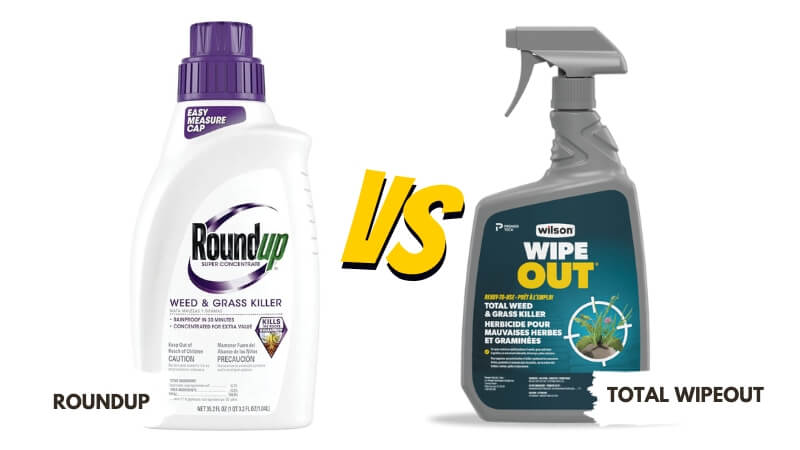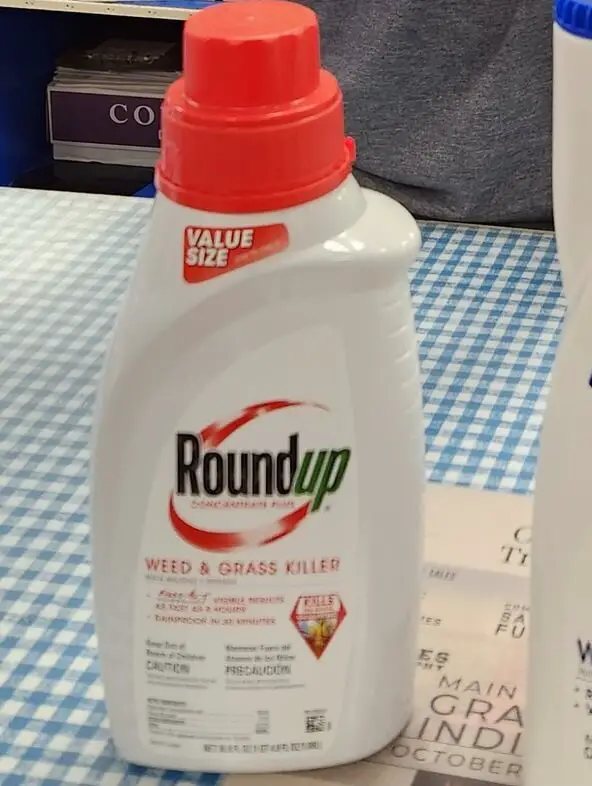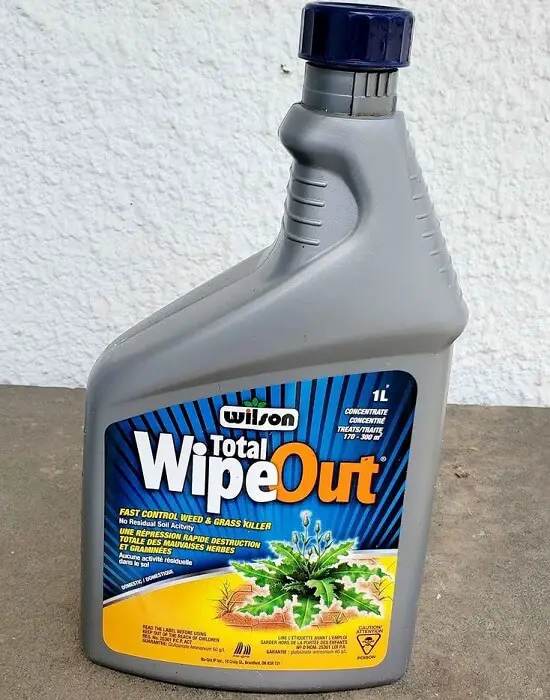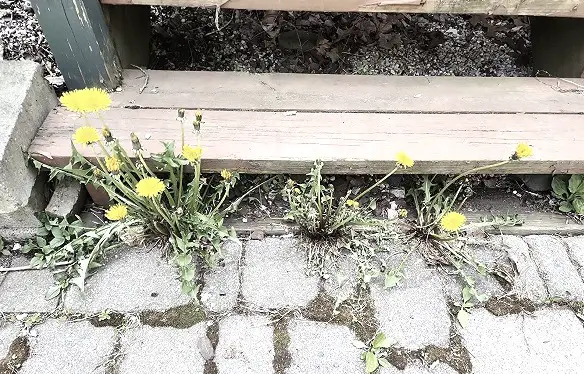Total Wipeout Vs Roundup

The main difference between Total Wipeout and Roundup weed killers is that Total Wipeout contains Ammonium Salt of Fatty Acid as the active ingredient, while Roundup contains Glyphosate.
Wipeout Vs Roundup Table
This comparison table will help you see the main differences between Total Wipeout and Roundup.
Total Wipeout | Roundup |
 |  |
Active Ingredient Is Ammonium Salt Of Fatty Acid | Active ingredient in Roundup Weed & Grass Killer is Glyphosate |
No residual soil activity, spray and plant the same day | Kills all types of weeds & grasses |
Mixing Ratio is 2.5 fl. oz. of the concentrate to 1 gallon of water. | Mixing Ratio 2.5 fl. oz. of the concentrate to 1 gallon of water |
Battery-powered sprayer makes it easy to get to hard-to-reach places | Easily apply with a Roundup brand tank sprayer |
Visible results within hours | Kills on contact with visible results as fast as 2-4 days |
Best results obtained with young, actively growing weeds. | Do not spray plants or grasses you like - they will die |
Effective against Algae, Carpetweed, Chickweed, Creeping charlie, Dandelion, Knotweed, Lichens, Liverworts, Plantain, Poison iv,y Quack grass, and more. | For use around flowers, shrubs, and trees; on patios, walkways, driveways, gravel areas, and mulch beds; along fences and foundations |
Overview
Total Wipeout is a contact herbicide that kills surface growth but not roots, allowing regrowth. Roundup is a systemic herbicide absorbed by plants and transported to the roots for complete plant death.
Overall, Roundup is more effective in a broader variety of weeds, while Total Wipeout breaks down faster in the environment.

Active Ingredients
The active ingredients are the chemicals responsible for killing weeds and grass. Total Wipeout contains Ammonium Salt of Fatty Acid as its active ingredient.
This is a contact herbicide, meaning it kills any part of a plant it touches but does not affect the roots. Roundup’s active ingredient is Glyphosate.
Unlike a contact herbicide, Glyphosate is systemic, which is absorbed by the plant and spreads to kill the entire plant, including the roots. This makes Roundup more effective at preventing regrowth.
What It Kills
Both weed killers are effective against common garden weeds like dandelion, plantain, poison ivy, and ragweed. Total Wipeout can also kill algae, nettles, milkweed, morning glory, pigweed, and more.
Roundup is also effective against tough weeds like bindweed, buckthorn, knotweed, and thistle. Overall, Roundup can tackle a wider variety of weeds, especially tougher perennials with deep root systems.
Visible Results
You will see faster results with Total Wipeout than with Roundup. Total Wipeout provides visible effects within hours, while it takes 2-4 days to see Roundup working.
However, Total Wipeout only causes surface damage, while Roundup kills the entire weed or grass plant.

Where To Use
Both weed killers can be used in flower gardens, gravel areas, patios, sidewalks, driveways, fences, and mulch beds. Total Wipeout can also be safely used on lawns.
Roundup should not be used in lawns, as it will kill the grass. It can be used around sturdy trees, shrubs, and woody ornamentals but care should be taken to avoid contacting desirable plants.
Mixing Ratio
To treat weeds, Total Wipeout is applied at full strength without dilution. Roundup is mixed at a ratio of 2.5 oz of concentrate per 1 gallon of water before use. Follow label instructions carefully when mixing either herbicide.
Where Not To Use
Avoid using Total Wipeout on desirable lawns and garden plants due to potential leaf damage. Also, avoid spraying in windy conditions when the herbicide could drift.
Do not use Roundup on lawns or flower gardens where it will kill grass and damage plants. Care should be taken around any desirable vegetation.

Application Timing
Both products work best when applied in warm, sunny conditions above 60°F. Total Wipeout can work in colder temps down to 59°F, but plant damage may take longer to appear.
Roundup is rainproof 30 minutes after application. Apply Total Wipeout or Roundup when weeds are actively growing for best results.
Pet Safe
When used according to label directions, both Total Wipeout and Roundup are considered safe for use around people and pets.
Avoid direct contact with either product and keep people and pets off treated areas until sprays have dried.
Repeat Applications
Repeat applications may be needed for both products. New weeds growing from seed will require spot treatment.
Tough perennial weeds may need a second application if not completely killed the first time with Roundup. Reapply Total Wipeout every 2-3 weeks to control regrowth of perennials and new seedlings.

How To Use
Total Wipeout is a ready-to-use product, so you don’t need to mix it with water. To use Total Wipeout weed killer:
- Shake it well.
- Turn the nozzle to the coarse setting so that it produces more significant drops. This will help reduce drift.
- Cover the weeds with the weed killer. If it rains within 3 hours of applying, you will need to repeat the treatment.
To use Roundup, spray the weeds or grasses you want to kill until they are wet. When you are treating weeds in a flower garden, shield plants you don’t want to eradicate from the spray with cardboard or plastic.
If a plant is accidentally sprayed, rinse it off with water right away. People and pets can enter the treated area after the spray dries but should avoid contact with the weed killer if possible.
Our Observation
After reviewing Total Wipeout and Roundup weed killers, we observed that both products are effective but work differently. Total Wipeout quickly damages surface growth but may require repeat applications for regrowth.
Roundup provides systemic control and prevents regrowth but takes longer to show effects. For fast-acting spot treatment, Total Wipeout may be preferred. When tackling persistent weeds or large areas,
Roundup would be the better option. Consider timing, application needs, and environmental factors when selecting these viable herbicide choices. Follow all label instructions carefully when using either product.

James E. Butkovich, Pest control maven with a knack for eco-friendly & Chemical solutions. Blogger with a mission to make homes pest-free, one post at a time.